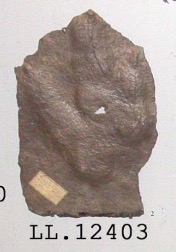Fossilised footprints may be the most overlooked types of fossil. Everyone knows about fossilised bones, teeth, eggs and even skin, however its as if the fascination with footprints just doesn’t exist.
Fossil footprints, scientifically known as ichnites, are a type of trace fossil. This makes it different to a true fossil, as it shows the indentation of a specimen, rather than the actual specimen itself.
Ichnites form when an individual leaves a footprint in soft sediment such wet mud, which leaves a large impression on the surface. The impression is then covered quickly by dry sediment, which would have stopped the imprint being damaged by erosion or abrasion. The sediment would have then been buried and became compacted and cemented enough to form rock which would have taken the shape of the impression left by the animal.
To the untrained eye, ichnites may only show the presence of whatever animal left the impression and not much else. However, they can in fact show us a lot more about the animal and the environment. They can show behavioural patterns, inter/intraspecific relationships, parental instincts, feeding habits and foot size (obviously) just to name a few.
Manchester Museum holds a specimen which shows Anomoepus footprints from different individuals. This could be interpreted in a few different ways. It may be possible that the animal travelled in groups, as multiple footprints are shown in one place. It could also show that the footprints were close to a source of food or water, or could potentially show parental instincts, as it shows footprints of different sizes, which could indicate the presence of adult and juveniles.

Grallator and Anomoepus are types of Ichnogenus. This means that the taxon is based entirely on trace fossils, even though it is possible that they belong to an already known genus, however, with the excpetion of rare casse, there is no way to know for sure exactly what genus created an ichnite. It may be possible that different Grallator footprints were made by different genera, however the ichnogenera of Grallator describes a small Triassic theropod, meaning they are all left by similar individuals.

One of my personal favourite fossil trackways is one I saw once on a Geology field trip to the Isle of Arran back when I was doing my A-Levels. It belongs to an Arthropleura, a genus of millipede from the Carboniferous, the time period most famous for the abundance of giant arthropods.
From this trackway alone we can work out how large the animal was and we can conclude that the land at the time was probably a tropical wetland, as the imprints would not have even formed otherwise.
From this, it is clear that fossilised trackways and footprints can give us a lot of information that other types of fossils cannot.
You can take a look at Manchester Museum’s collection of fantastic fossilised trackways online or after the 17th of May, when we are back open for visitors.
References
– Briggs, D. E. G.; W. D. I. Rolfe & J. Brannan (1979). “A giant myriapod trail from the Namurian of Arran, Scotland”. Palaeontology. 22: 273–291.
– National Park Service. 2015 Dinosaurs. [online] Available at:<https://www.nps.gov/dino/learn/nature/dinosaurs.htm>
– Olsen, Paul & Rainforth, Emma. (2003). The Early Jurassic ornithischian dinosaurian ichnogenus Anomoepus.
– Stonecountrypress.co.uk. 2010. Limestone on Arran. [online] Available at: <https://www.stonecountrypress.co.uk/2010/03/limestone-on-arran.html>
Filed under: Uncategorized |




Leave a comment